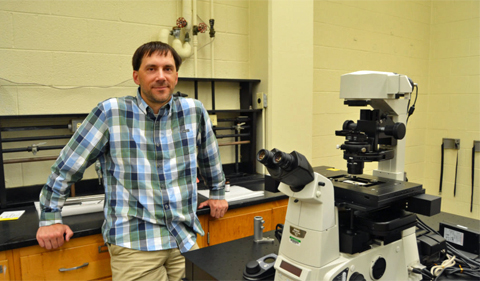
Anthony Stender in his microscopy lab at Clippinger. He joined NQPI in March 2017.
By Raymond Humienny
NQPI writing intern
The trip to tenure track in academia is a windy road. The Nanoscale and Quantum Phenomena Institute’s newest member and Chemistry & Biochemistry professor Dr. Anthony Stender knows the journey all too well.
“I had no interest in chemistry when I first went to college, and I did poorly in general chemistry; it never crossed my mind that I would eventually be a chemist,” Stender said. “But then … I was encouraged by a friend to enter a forensic science program and decided to give that a try.”
Stender completed a bachelor’s in math at the University of Wisconsin at River Falls and a master’s in meteorology from the South Dakota School of Mines and Technology prior to his forensic science endeavors. Set on attaining a Ph.D.-level position, he would find himself studying rod-like plasmonic nanoparticles at Iowa State University.
“The joke we shared in our research group was: ‘on paper, I’m an analytical chemist,’ but none of us were doing traditional analytical chemistry research. I was doing a lot of physical chemistry and microscopy,” Stender said.
Jokes aside, Stender has been accredited with a hefty set of scientific tools: multiple forms of optical microscopy, nanoengineering, and a fellowship at Rice University in Texas that helped craft a unique approach toward forensic research based on his prior nanoscale research.
“One thing that appealed to me (at Ohio University) was the opportunity that I could do some nano-related research, I could do some microscopy, but I could also do some forensic-related research,” Stender said. “Those are the three areas that I want to research with students because those are the three things that keep me the most interested in chemistry.”
Analyze, Verify, Spectroscopy + Imaging, down to the Nano
Today, Stender leads the AVSTIN (pronounced “Austin”) Microscopy Lab, which stands for “Analyze, Verify, Spectroscopy + Imaging, down to the Nano.” Research topics range from plasmonics to forensic analytical chemistry using single particles – though Stender is not short of ideas for future students to explore. Specifically, Stender hopes to use a “single particle at a time” approach to investigate the gap between the macro- and nanoscale levels of measurement, especially in regards to forensic research. Forensic microscopy rarely ventures below the microscale, but there is a growing interest to go there.
“You’ve got this gap region between 100 nanometers and a micrometer, which is this in-between scale,” Stender said. “What’s interesting is that gold particles between 10-100 nanometers have very specific optical behavior; but once you start growing beyond 100 nanometers – the bigger you get – you start to blur the lines of is it nanoscale behavior, or is it like a bulk material?”
Hence, Stender’s goal is characterization: to understand how properties change as you take a particle from one end of this scale to the other.
“Because I am somebody who has expertise with nanomaterials, and forensic science is still mostly focused on the macro scale, it is sort of like, ‘how do you bridge that gap between those two interest groups?’” Stender said. “It seems like there is an opportunity there to do some interesting research with students.”



















Comments